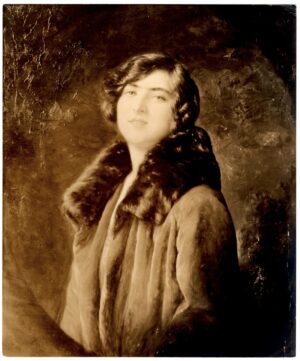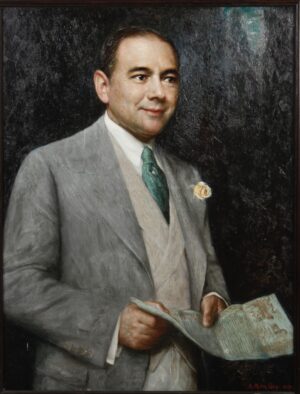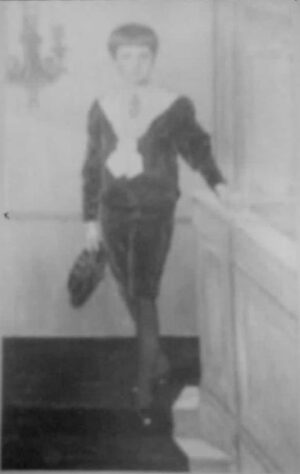McKINLEY, President William
Description:
Oil on canvas, 78.5/16” x 43.15/16” (198.9 x 111.6 cm.), signed and dated lower left ‘A Muller Ury 1900 (redated 01)’. Full-length facing left, almost in profile, standing on a reddish carpet, dressed in black with a white waistcoat and shirt and black tie, his left hand in his trouser pocket and his jacket drawn back, holding some papers in his right hand.
Location:
National Portrait Gallery, Washington D.C. (NPG.97.157)
Provenance:
The artist; sold in his studio sale Plaza Art Galleries New York, November 28th and 29th, 1947
Public Sale No. 2809, Lot 162A (Fetched $10.00 – marked copy in Frick Art Reference Library); Jessica Dragonette; sold from her collection 1970s; acquired by Sidney Sands; inherited by his niece and nephew Sidney Wolff; purchased by the National Portrait Gallery, Washington D.C., December 18, 1997.
Exhibitions:
THE CORCORAN GALLERY OF ART, Washington D.C., January 1902
THE CORCORAN GALLERY OF ART, Washington D.C., June 1902
NOE ART GALLERIES, 368, Fifth Avenue (between 34th & 35th Street), New York, January 5 – 19, 1903.
Probably FRENCH & CO. INC., New York, April 21 – May 3, 1947, No. 8.
GEORGE BUSH PRESIDENTIAL LIBRARY AND MUSEUM, College Station, Texas, October 6, 2000 – January 15, 2001, and other touring venues in the USA.
Bibliography:
Mitchell C. Harrison (compiler), New York State’s Prominent and Progressive Men: An Encyclopaedia of Contemporaneous Biography, Volume 3, New York, 1902, p. 243
Vogue, New York, February 8, 1902
New York Herald, Paris, France, March 20, 1902
New York Journal, April 8, 1902
Washington Post, May 16, 1902
Record, Philadelphia, May 27, 1902
Press, Philadelphia, May 27, 1902
New York Press, May 27, 1902
New York Tribune, May 27, 1902
Herald, Baltimore, May 27, 1902
Washington Post, May 27, 1902
Weekly Democrat, May 29, 1902
Washington Star, May 31, 1902
Mirror, Washington, June 5, 1902
Town Topics, Thursday, November 27, 1902
New York Evening Telegram, January 7, 1903
Mail & Express, New York, January 10, 1903
Vogue, Vol. 21, Issue 3, January 15, 1903, p. iii
Art Interchange, February 1903
Vogue, September 24, 1908, ‘Portrait Painters of Today’, p.445
American Art News, Vol. XLVI, New York, April 1947, p.45
Frederick S. Voss, Portraits of the Presidents: The National Portrait Gallery, Washington and New York, 2000, pp90-91, illustrated in colour.
The sitter was born on January 29, 1843 in Niles, Ohio, became a teacher and then enlisted as a private in the army in 1861, where he was given an award by President Lincoln for gallantry in battle, March 13, 1865. After the Civil War he trained as a lawyer in Ohio and in Albany, being admitted to the Bar in 1867, settling in Canton, Ohio. He married Ida Saxton in 1871. He then entered politics and was a member of Congress 1876-91, and re-elected in 1893. Although supported for office of President at the Republican convention of 1892 he chose to support re-nomination of Benjamin Harrison. However, in St. Louis on June 18th, 1896 he received 661 of the 905 votes for the Presidential nomination. He was finally elected President of the United States in November 1896, this being repeated in June 1900 by an increased number of votes. His administration focused on American indignation over conditions in Spanish Cuba which led to war with Spain and the eventual surrender of the Phillipines, Puerto Rico and Guam to American control. He was assassinated in office as President at Buffalo, New York on September 6, 1901.
Bibliography:
Margaret Leech, In the Days of McKinley, 1959
Howard W. Morgan, William McKinley and his America, 1964
Charles S. Olcott, The Life of William McKinley, 2 Vols., 1916
William C. Spielman, William McKinley, 1954
—
According to an Intern Student at the National Portrait Gallery in 1997/8, Michelle Kloss, Muller-Ury based this picture on a photograph taken by Francis Benjamin Johnston, just days before McKinley was assassinated on 14th September 1901, but as the picture was originally dated 1900, and only subsequently redated 1901 (the change is clearly visible with the naked eye) it is more likely that the artist was using his knowledge of painting the President in November 1899 and known images of the President in characteristic standing pose (published in newspapers etc) to create this standing portrait.
In Mitchell C. Harrison (compiler), New York State’s Prominent and Progressive Men: An Encyclopaedia of Contemporaneous Biography, Volume 3, New York, 1902, p. 243, is the following passage relating to this portrait:
‘The late President McKinley gave the last sitting for his portrait to Mr. Muller-Ury. This one portrait is not only the most perfect likeness of the late President, but may be the most lifelike portrait the artist has ever painted. It represents the President standing making a public speech.’
Before being sent to France (for the 1902 Salon committee to judge) this picture was loaned to the CORCORAN GALLERY OF ART in Washington (see, Vogue, New York, February 8, 1902). The New York Herald, Paris, France, March 20, 1902, reporting on pictures arriving at the Societe des Artistes Francais for the forthcoming Salon, said that ‘Among the works handed in while a HERALD correspondent was chatting with M. Vigneron, the obliging secretary of the society, was a full-length portrait of the late Mr. William McKinley, signed “A. Muller Ury.” It must have been rejected by the Salon, for letters in the Domestic Letterbook of M. Knoedler & Co. (24 March 1902—30 August 1902: Nos. 385, 403, 407 and 435), indicate that a portrait of McKinley was returned from Le Havre on the S.S. “La Touraine”, for which Muller-Ury paid the dealer’s disbursements of $45.93 on June 26, 1902. The first letter in the Knoedler Letterbooks is undated but presumably predates the fact that Muller-Ury exhibited the portrait of McKinley at a studio tea he gave on April 7, 1902, according to the New York Journal, April 8, 1902, and that in May the full-length picture was exhibited at Depew’s home in Washington, and the press ruminated that Congress might be asked to purchase this for the White House. [In that connexion Muller-Ury sent a portrait of McKinley back to the Corcoran for exhibition in the latter half of June 1902 (letter from the Clerk of the Gallery, in artist’s papers), and therefore this cannot have been the seated version.] Vogue, September 24, 1908 states that this ‘..full-length, standing portrait of the late President McKinley was the last portrait for which he sat. This now hangs in the artist’s studio and is an excellent likeness. It represents the President as about to deliver an address.’ Vogue, Vol. 21, Issue 3, January 15, 1903, p. iii, commenting on its exhibition at Noe Gallery, said, ‘Mr Muller-Ury’s portraits will also remain on view in this gallery until the end of the week. Among them is a full-length portrait of President McKinley, posed in a dignified and natural position.’
It is impossible to be certain that this is the portrait recommended as a suitable purchase for the White House by Depew to Senator George Peabody Wetmore, in Newport, Rhode Island, in a letter of November 11, 1901 a copy of which is in the artist’s papers. Wetmore was one of several members of Congress who were persuaded to see the picture, another being T. C. Platt of the Senate Committee on Printing (Letter January 11th, 1902; same source). Certainly, General Corbin wrote to Muller-Ury on March 28, 1902 (same source) stating ‘…I have been talking to several members of the Library Committee, and I think I have awakened some interest in your portrait of Mr. McKinley, and I shall keep at work at it.’ Senator Depew wrote to the Editor of the Washington Evening Star, Crosby S. Noyes, on May 26, 1902, requesting his critic visit his home to see the portrait of his wife and this picture: ‘Mr. Muller-Ury also has here a very fine portrait of President McKinley finished shortly before his death which I should be pleased to have your representative see.’ (Archives of American Art) Wetmore, who was on the Senate Library Committee, wrote to Muller-Ury on June 2, 1902 (letter in the artist’s papers) that though he had been unable to see the portrait (perhaps at the Corcoran), he would ‘..try to find an early opportunity to do so.’ On June 25, 1902 Edythe Corbin wrote to the artist saying she had been to see the portrait of McKinley ‘…and I do think you have done all that can be done – it is a splendid likeness and I hope that the Powers will find it so, but one never can tell, there seem to be so many wheels within wheels here…’ (same source) And, Senator Hanna replied to the artist’s importunity on June 3, 1902 saying that he hoped to have ‘…an opportunity to see your portrait of the late President McKinley before it leaves Washington.’ (same source).





